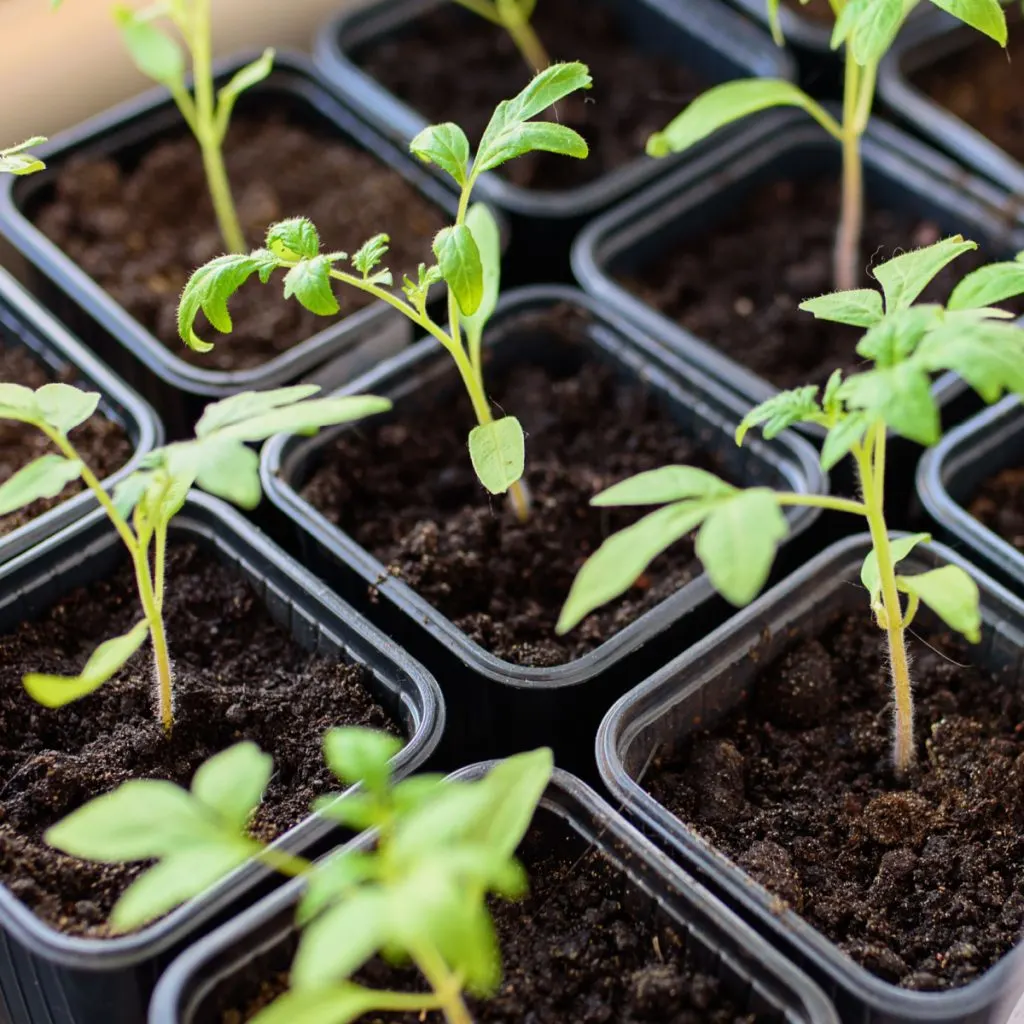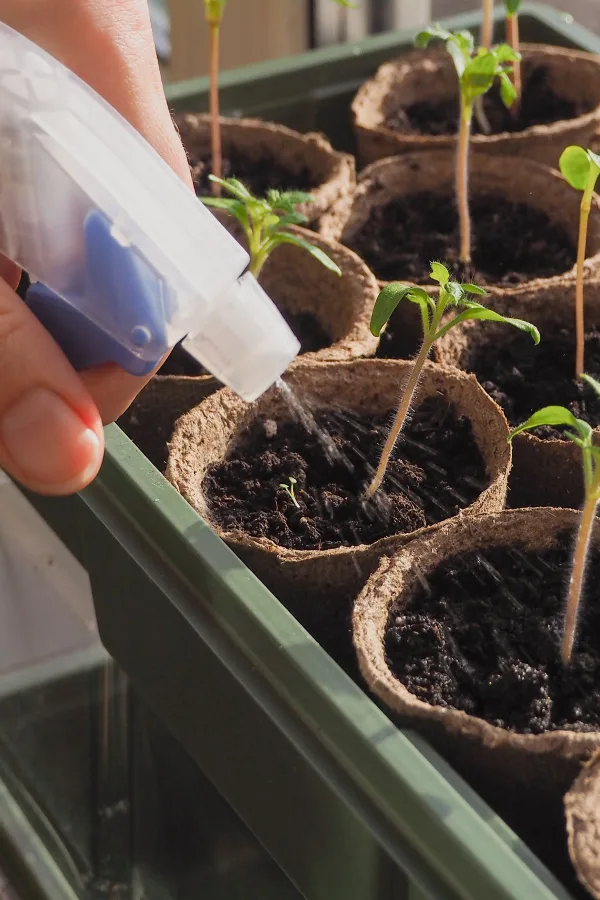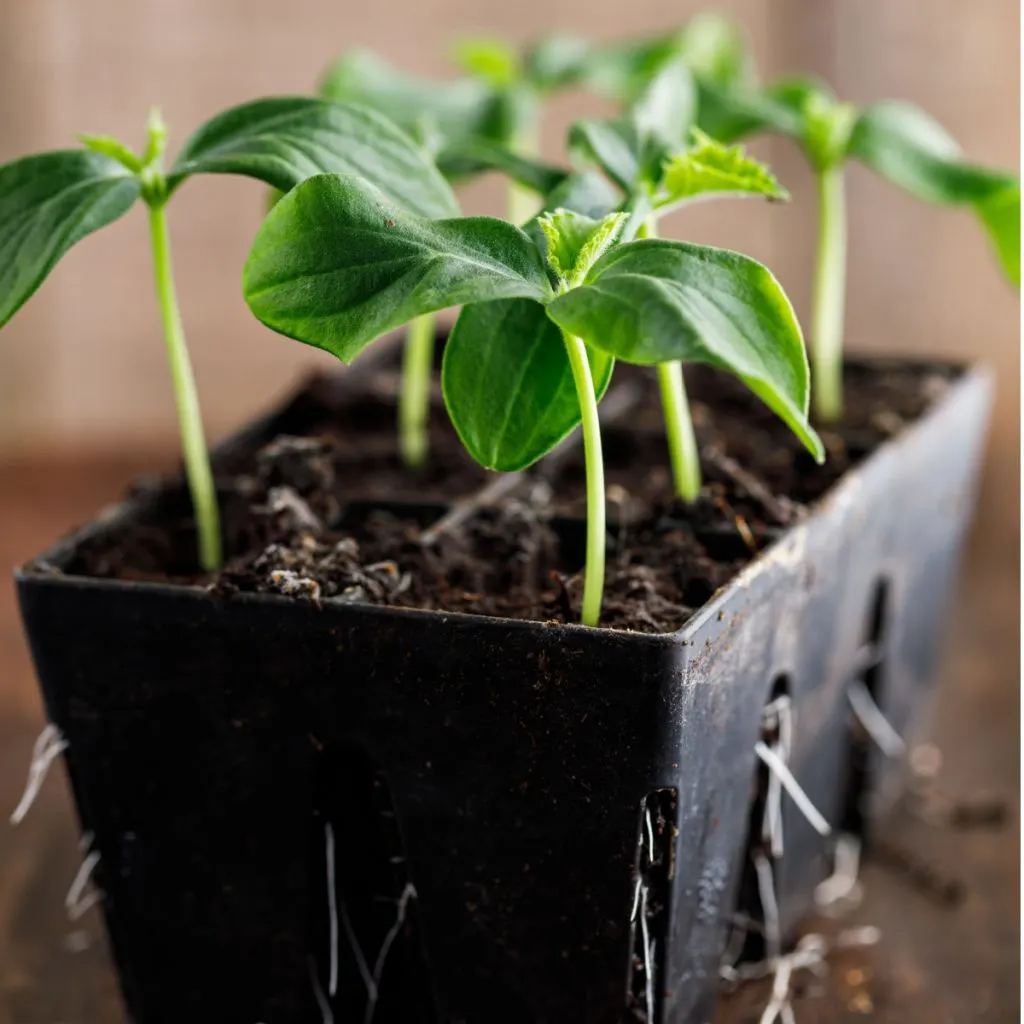If you are wondering how to get all of those tiny plants you started from seed indoors to start growing big and strong in quick fashion – it’s time to give your young seedlings and transplants a little boost of fertilizer!
More and more gardeners are learning how fun it can be to grow their own plants from seed. Starting your own vegetable plants or flowers opens up your growing world to all kinds of unique, tasty and colorful varieties.
But if there is one thing many gardeners who grow their own plants struggle with, it’s how to get their tiny plants to grow big and strong enough in time for planting day outside. More times than not, the issue all comes down to the plants not getting or having enough energy and nutrients to develop fast. And that is exactly where fertilizing them early in their life can come to the rescue!

Many gardeners are surprised to learn that you can and should give a little fertilizer to tender, young seedlings. It is true that after only a few weeks of growth, seedlings can often look quite weak and feeble. But that doesn’t mean they can’t benefit from a little pick me up. In fact, as soon as seedlings are a full two weeks old – it’s exactly what they need!
But as you will see below, the simple secret to growing success is to give your tiny plants just the right dose – and in just the right way. And when you do, they it can jump start them to amazing new growth!
How To Fertilize Seedlings & Transplants
When fertilizing seedlings and small transplants early in their life cycle, it’s important is to give them a lower dose of nutrients. It’s also vital to give those nutrients to the plants in a form they can both absorb and handle with ease. And the best way to do that for seedlings and transplants is by using a liquid fertilizer.
Liquid fertilizers absorb into plants in two unique ways. First, when the liquid passes through the soil, it absorbs into the roots below the surface. Because it is in a liquid form, that absorption occurs quickly. For the roots of small plants, it is the exact same process of taking in water to hydrate.
But liquid fertilizers can also absorb through the foliage and stems of plants. This means when you water, mist or even spray your young plants with liquid fertilizer, they also get a dose of additional nutrients right through their leaves.

This “double” dose of nutrients can be extremely powerful for plants – and a very quick way for them to develop and grow fast. But, and this is key, you have to be very careful what type of liquid fertilizer you give your young seedlings – especially when it comes to the overall strength and consistency of the dose.
Selecting The Best Fertilizer For Seedlings & Transplants
There are three great options for fertilizing young plants. The first is to use all-natural compost tea. The second is to use all-natural worm casting tea. The third and final option for fertilizing young seedlings is to use a commercial liquid fertilizer – but as you will see below, when using that option, you will need to use a bit more caution.
It is always best to allow your seedlings to reach at least two full weeks in age before giving them a light dose of liquid fertilizer. Any earlier, and the energy can actually harm more than help.
Let’s now take a look at how to use each of the above options to get your plants growing fast! Again, any of the three can work wonders, it really comes down to personal preference and availability.
Fertilizing Indoor Seedlings & Transplants With Compost Tea
Compost tea is made from soaking aged compost in water and allowing the nutrients to soak into the water. Compost tea is ideal for young seedlings because the nutrients within it are pure, but never overpowering.
Listen In To Our Podcast Below On How To Make Great Compost Tea!
To make compost tea, all you need to do is steep compost in water for a few days. When using for seedlings, we like to mix about two cups of compost in a gallon of water. Two or three times each day we stir it or shake it up. Affiliate Link: Charlies Bagged Compost
Then after two to three days, we strain the compost from the liquid. Then, simply water your plants with it! If plants are too small, use a mister. As they grow larger, you can water the surface of the soil and mist the leaves for a double dose of power.
There is no need to ever dilute compost tea. The nutrients are truly an almost ideal low and slow energy source and will not burn foliage or the roots of tender seedlings. For best results, apply compost tea every 10 to 14 days until you are ready to plant outdoors.
Fertilizing Indoor Seedlings & Transplants With Worm Casting Tea
Like compost tea, worm casting tea is created by soaking worm castings in water and letting its power leach into the liquid. Much as with compost tea, the nutrients are pure but never overpowering in worm casting tea. Nor is there is never a need to worry about diluting the liquid tea, it too can be used at full strength. See: How To Use Worm Castings To Power Plants
To make, use 1/4 to 1/2 cup of worm castings and allow to steep in water for a few days. Shake or stir the ingredients to help the water absorb the energy in the castings a few times each day. All that is left is to strain and water plants every 10 to 14 days until planting day.

Fertilizing Indoor Seedlings & Transplants With Organic Fertilizer (Commercial)
If compost or casting tea are not an option, you can also use a quality liquid organic fertilizer off the shelf. However, when using this, you will need to dilute! At full strength, commercial fertilizers have too much strength for young plants.
The best advice is to mix the fertilizer to about 1/4 to 1/5th the recommended strength. This will keep plants from getting too many nutrients all at once. This will also allow you to still give regular doses every 10 to 14 days for a continuous supply. Affiliate Link: Espoma Organic Grow! Liquid Concentrate Plant Food
That consistently is actually the most important of all for young seedlings – no matter which liquid fertilizer you use. By giving them low but regular doses of energy, they can slowly but continually grow – without the worry of overgrowing.
Here is to powering up your young seedlings with a little fertilizer now. And to having big, beautiful, well developed transplants that are ready to hit the ground growing on planting day!
This Is My Garden
Follow Our Facebook Page For Great Gardening Tips And Advice! This Is My Garden Facebook Page
This Is My Garden is a garden website created by gardeners, for gardeners. Jim and Mary Competti have been writing gardening, DIY and recipe articles and books and speaking for over 15 years from their 46 acre Ohio farm. They publish three articles every week, 52 weeks a year. Sign up today to follow via email, or follow along!
